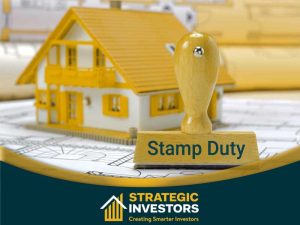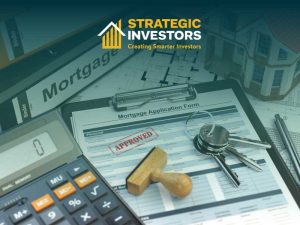
If you’re purchasing property, understanding “what is stamp duty” is crucial.
This tax affects your total buying cost and varies across regions, depending on the property’s value.
Our article demystifies what is stamp duty, detailing how it’s calculated, when it’s due, and what exemptions may apply, ensuring you’re well-prepared for this often-overlooked expense of property acquisition.
Key Takeaways
- Stamp duty is a tax on property transactions that is used to fund public services and varies widely by state and territory in Australia.
- Calculating stamp duty depends on factors like the property’s sale price or market value and can be estimated using online calculators, although final amounts should be confirmed by a professional.
- Concessions and exemptions on stamp duty are available for certain groups like first-time buyers or other eligible individuals, which can vary significantly across different jurisdictions.
Demystifying Stamp Duty: The Basics

This tax is commonly levied on property transactions. If you’re buying a property in Australia, whether it’s a house, holiday home, investment property, or vacant land, you, the buyer, pay the stamp duty. However, the amount varies depending on the state or territory. It’s not a small sum either; it can amount to tens of thousands of dollars. Hence, familiarizing yourself with its workings and potential costs is a key aspect of budgeting for a property purchase.
But don’t get confused if you hear other names for stamp duty, such as transfer duty or conveyance duty. They all refer to the same thing – the tax you pay when buying a property.
Stamp Duty Defined
At its core, stamp duty tax is a levy on property transactions. It serves as a key component of government revenue, helping fund various community benefits, such as public services and infrastructure improvements.
Thus, your stamp duty payment when purchasing a property aids in the development of the community.
The Mechanics of Paying Stamp Duty
The process of paying stamp duty is straightforward. It’s payable by the buyer at the time of settlement, which usually occurs between 14 to 100 days after the contract is signed. If you’re not using a solicitor or conveyancer, then you will have to lodge an application and pay the duty on your own. This is an important responsibility to ensure the legal process is properly completed. However, if you are, they can handle the stamp duty payment as part of the settlement process.
The settlement process of purchasing a property essentially includes the payment of stamp duty, which the buyer pays stamp duty as part of the transaction
Variations Across Jurisdictions
While stamp duty is a common factor in all property transactions, it is not uniform across Australia. The rates and rules vary significantly between different states and territories due to their independently set policies. For instance, in Queensland, stamp duty is computed based on the higher value between the unencumbered property value or the purchase price, while Victoria imposed increased rates on properties valued over $2 million.
These variations, specific to jurisdictions, play a significant role in shaping property investment decisions across Australian states and territories, including the Australian Capital Territory.
Calculating Your Stamp Duty Obligation

Factors Influencing Stamp Duty Costs
The calculation of stamp duty involves considering factors such as the property’s sale price or market value. The amount of stamp duty payable is based on the higher amount between the property’s sale price and its current market value, ensuring a minimum tax threshold is met.
Rates of stamp duty vary dependent on the property type, be it residential homes or vacant land, and are influenced by price thresholds set by local jurisdictions.
Using Stamp Duty Calculators
Online stamp duty calculators provide estimates for potential stamp duty payments based on property values and specific rates in the buyer’s state or territory. All you need to do is input the purchase price, select your state or territory, specify the property type, and your status as a first-time or subsequent homebuyer.
Remember, as helpful as calculators are, they merely provide a rough estimate of expected stamp duty costs. For final figures, always consult a mortgage expert, solicitor, or conveyancer.
Navigating Stamp Duty Exemptions and Concessions

- Queensland offers a stamp duty concession on the first $350,000 for all home buyers purchasing a primary residence.
- Special provisions are available in Victoria for Australian Defence Force members.
- Temporary exemptions for eligible transactions during specific periods are available in various states.
Concessions may be offered by governments to stimulate property purchases in certain areas or promote housing affordability and labor market flexibility.
Criteria for Stamp Duty Concession
Eligibility criteria for stamp duty concessions differ across states. For example, in Victoria, first home buyers are eligible for a complete exemption from duty when purchasing a home valued at $600,000 or less for duty purposes. In Western Australia, concessions for properties valued up to $530,000 are available and first-home buyers are exempt from stamp duty on purchases up to $430,000. It’s crucial to check the criteria for your state to understand your eligibility.
Seeking Full Exemption from Stamp Duty
Full stamp duty exemptions are also available in certain scenarios. First home buyers are eligible for a stamp duty exemption, subject to caps on the sale price of the property. Other individuals, such as healthcare card holders, Indigenous people, pensioners, or farmers, may also qualify for full exemption from stamp duty in certain states or territories.
In instances of divorce or death, family property transfers might be exempted from stamp duty, a significant factor for estate planning.
The Role of Stamp Duty in Property Investment

The extra expense of stamp duty can sway investment choices, prompting potential buyers to reevaluate their decisions to purchase, relocate, or downsize.
Stamp Duty Implications for Investors
From an investor’s viewpoint, considering the impact of stamp duty on investment costs and long-term returns is vital. Differential stamp duty rates for investment properties compared to owner-occupied homes can influence investors’ decisions on property purchases. Additionally, stamp duty is not tax-deductible, which affects the overall cost implication for investors.
Strategies to Minimize Stamp Duty for Investors
Regardless of the potential strain of stamp duty, investors can employ strategies to mitigate its effect. Seeking independent financial and taxation advice before acquiring an investment property is crucial for effective tax planning and minimizing liabilities, including stamp duty.
Geographical diversification across different states can help minimize land tax, as each state has its own tax-free threshold.
Understanding Transfer Duty and Its Application

Transfer Duty vs. Stamp Duty
Essentially, transfer duty and stamp duty are synonymous, with the terms being used interchangeably. Historically, stamp duty required the attachment of an official revenue stamp to documents as a form of payment verification, resulting in stamp duty paid. In such cases, stamp duty applies.
It applies to a range of transactions including the transfer of real estate and business property.
When Transfer Duty Applies
Transfer duty is applicable to a variety of transactions, including:
- the sale, purchase, or transfer of a property, encompassing land or land rights
- establishing or acknowledging a trust over property
- granting or transferring an option to purchase land
- creating a life estate
- foreclosing a mortgage on a property in NSW
All of these transactions require payment of transfer duty.
The Impact of Stamp Duty on the Property Market

Since the 1980s, stamp duty costs for median-priced homes have surged at a rate at least four times that of average incomes.
Stamp Duty as a Market Regulator
Apart from its financial consequences, stamp duty affects the liquidity of the housing market, functioning as a market regulator. Cities with significant increases in housing prices have seen a correlating decline in market liquidity due to the impact of stamp duty.
The Debate Around Stamp Duty Reform
The impact of stamp duty on the property market has sparked a lively debate around potential reforms. Proposals in New South Wales offer an annual land tax option as an alternative to upfront stamp duty for properties valued at $1.5 million or less.
Advocates for stamp duty reform argue that it encourages market liquidity and more efficient use of housing stock, potentially boosting the supply of existing property by up to 4%.
Preparing for Stamp Duty Payment

It’s vital to include stamp duty in the overall budget when saving for a home.
Budgeting for Stamp Duty
Prudent budgeting is crucial when dealing with stamp duty. As you save for a home, strive to amass at least 20% of the home’s purchase price, along with a surplus to cater to additional expenses like stamp duty. It’s crucial to account for stamp duty when determining how much can be borrowed for a house to ensure realistic budgeting.
Options for Paying Stamp Duty
As for paying stamp duty, a few options are available. While stamp duty cannot be added to the principal amount of a home loan and is typically an upfront cost that must be paid upon settlement of the property, buyers may opt to fund stamp duty by reducing their home deposit, thereby increasing the overall home loan amount.
Summary
Navigating the intricacies of stamp duty can be challenging, but with the right knowledge and understanding, it becomes manageable. From its historical roots to its pivotal role in property transactions, stamp duty is a significant factor in the financial landscape of property buying. Whether you’re a first-time buyer, an investor, or someone looking to understand the property market better, it’s crucial to understand how stamp duty works, how it’s calculated, and how it impacts your property investment decisions.
Frequently Asked Questions

What is the stamp duty in Australia?
Stamp duty in Australia varies by state, typically ranging from 3-4% of the property value. For precise calculations, it’s best to use a stamp duty calculator.
What is stamp duty in Qld?
Stamp duty in Queensland, also known as transfer duty, is a state government tax applied to the sale or transfer of property, as well as other personal and business-related assets like vehicles. It is a percentage of the property price and can amount to tens of thousands of dollars on average.
How much is the stamp duty in WA?
The stamp duty in WA is calculated at a general rate. It would be best to check with the local government for the specific amount.
How is stamp duty calculated?
Stamp duty is calculated as a percentage of the property’s value at the time of purchase. You can use online calculators to estimate the amount.
Are there any exemptions or concessions on stamp duty?
Yes, there are state-specific exemptions and concessions that can reduce the stamp duty payable. These can vary by location and circumstance.













